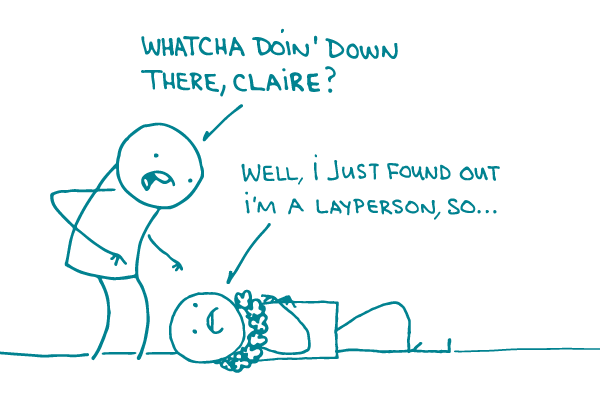
This week, we’re thrilled to add to our frequently asked question series by answering a great question that came from one of our regular readers: What do you think of the term “layperson”? (The context here, in case you’re wondering, is the difference between a health care professional and a consumer.)
You may not be too surprised, dear readers, to find out we’re just not that into “layperson.” First, it’s a weird word. There’s nothing intuitive about it — and it’s not used all that often anymore. It also hits a vaguely religious note, which usually isn’t necessary when it comes to health information.
Finally, the word epitomizes the relationship that we try not to establish between health information communicator and health information consumer — that is, we (health communicators) are the in-the-field experts and you (consumers) are the outsider non-experts. That is something we do not ❤︎ at all — and it flies in the face of some of our core plain language principles, like writing in familiar language and avoiding condescending language.
Those are our thoughts on the term itself — but our inquisitive reader, perhaps anticipating our feelings about “layperson,” also asked if we could suggest some alternatives. And in another perhaps not-so-shocking turn of events, we’d say that answer comes down to knowing your audience.
The tips we offer from We ❤︎ Health Literacy Headquarters mostly apply to content for consumers. So our approach is generally not to label the consumer audience with anything beyond the second-person “you” — for example, “Treatment for Diabetes: What You Need to Know,” not “Treatment for Diabetes: What Consumers (ew)/Laypeople (ick!) Need to Know.” We’d be more likely to call out a resource that’s not meant for consumers — like if we created one for professionals: “Treating Diabetes: Information for Professionals.”
From our perspective, then, it’s generally not necessary to call laypeople “laypeople” at all — or “consumers” or “the public” or whatever other term you can come up with to distinguish consumers from non-consumers. But if you write mainly for a professional audience and you do want to distinguish the consumer audience, “patient” is probably a safe bet overall. You may also be able to specify within a consumer audience depending on the topic (like “pregnant women”).
Either way, we empower you to skip “layperson.”
The bottom line: Forget about the term “layperson” in your health communication materials. (And if you already have, pretend we didn’t remind you!)
Browse recent posts